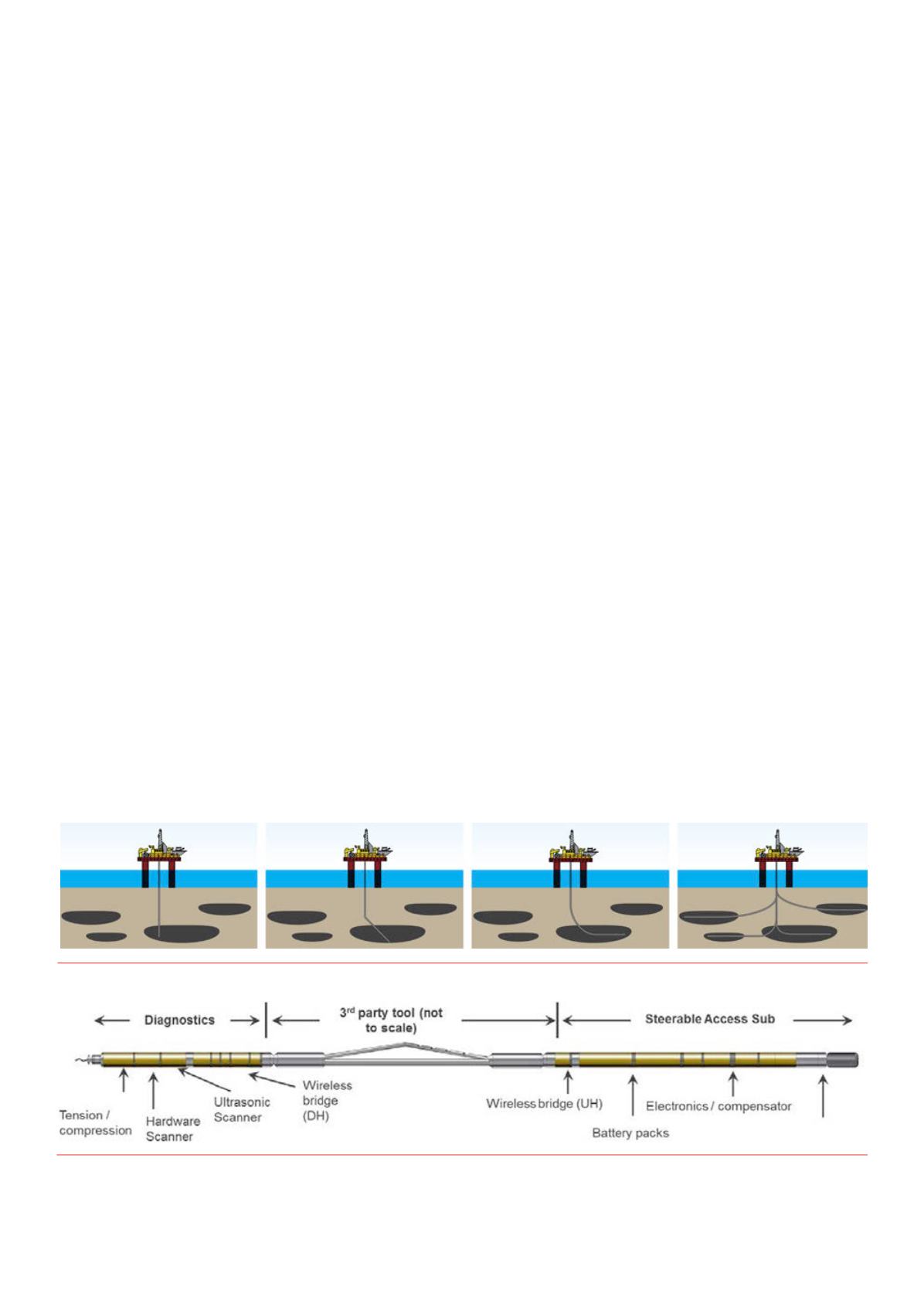
38 |
Oilfield Technology
June
2016
PLTs into the multiple legs of the wellbore was missing – until
now.
Theattractionofmultilaterals
Maximum reservoir drainage from minimal locations is what
lies behind the increased number of multilaterals that have
been drilled and completed in the last few decades. Multilateral
technology has evolved to offer not only the ability to drain
reservoirs more efficiently but also to potentially drain multiple
reservoirs simultaneously and with fewer surface locations.
Conventional wells were drilled vertically through the
reservoir, producing only from the vertical surface area uncovered.
In order to drain a large areal expanse, lots of wells were required.
As technology advanced, however, operators began to drill
deviated wells which by virtue of geometry alone increased the
exposure to the reservoir and (ideally) increased production
(Figure 1).
As technology continued to advance, horizontal wells
became much more prevalent; today dominating the total
number of wells drilled each year. This technique has had
tremendous impact across the globe, turning previously
uneconomical reservoirs into producers. Not only with the
highly documented shale oil and gas successes of the US, but
also in more classical lithology. A recent example from Norway
which demonstrates this is the Smorbukk South Extension
in the Asgard field. Originally discovered in 1985, its low
permeability prevented it from being completed. Recently,
however, long horizontal reservoir sections have been drilled
accessing the tight reservoirs. One of these oil and gas producers
was a multilateral with 17 060 ft of total reservoir exposure, a
significant advancement from the days of vertical drilling.
Technology infrequently develops in isolation and
improvements to horizontal drilling are no exception. Several
other enablers evolved in parallel; the abilities to ‘see’ better and
to ‘target’ better. This means that operators are now equipped
with the ability to identify reservoirs (or sections of reservoirs)
that were previously unidentified due to their size, characteristics
or proximity to geological artifacts that would hide them. Once
identified, the advances in ‘geosteeering,’ the ability to control the
bit during the drilling process, vastly increase the likelihood that
these targets can be accessed.
Hence the simultaneous development of multiple technologies
has led to the increased drilling and construction of horizontal,
multilateral wells. Many smaller reservoirs or sections which
were not economical to pursue individually due to their size or
location can now be combined into a single well. Or if they could
be accessed from a previously drilled well then they could be
brought onto production as part of the existing infrastructure.
These abilities have opened up a new mindset for well design as
technology is now available to find, target and access multiple
reservoirs or sections from a smaller number of well slots or pads,
reducing the cost of well construction while increasing production
and maximising reservoir drainage.
Datadrivesdecisions
Today’s society is largely influenced and driven by data. This is
also true when trying to optimise and increase total reservoir
drainage. Much time and effort is spent modelling and designing
the proper well placement in three dimensions for the best
possible solution. Production and subsequently total drainage
volume are impacted significantly by reservoir characteristics,
but even more so when trying to combine multiple reservoirs in
the same wellbore with the implementation of multilaterals.
1
It is not only well placement considerations that benefit
from correct data about the reservoir. Production data can help
reduce uncertainties in reserve estimates, sweep efficiencies
and in the case of multilaterals, pressure information which can
aid in detecting cross flow or preventing production below the
bubble point in the respective lateral.
2
The data about the reservoirs can be acquired from a
number of sources; seismic acquisition, during drilling or with
open hole logging but one of the most common ways to acquire
production data is via e-line conveyed PLTs. Fast, efficient and
sensor heavy, these tools can provide real time measurements
and surface read-out of fluid velocities, fluid types, borehole
pressure and temperature, formation capture cross section and
others. From these measurements a tremendous amount of
information about the reservoir and even the completion design
Figure 1.
Illustration of the evolution of increased reservoir contact.
Figure 2.
Schematic of 2⅛ in. multilateral intervention tool.


